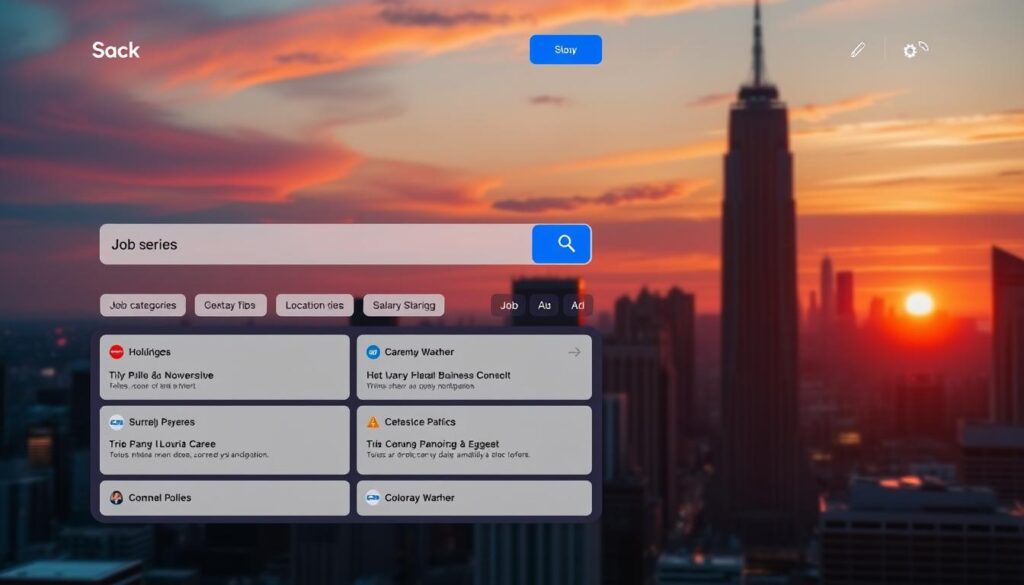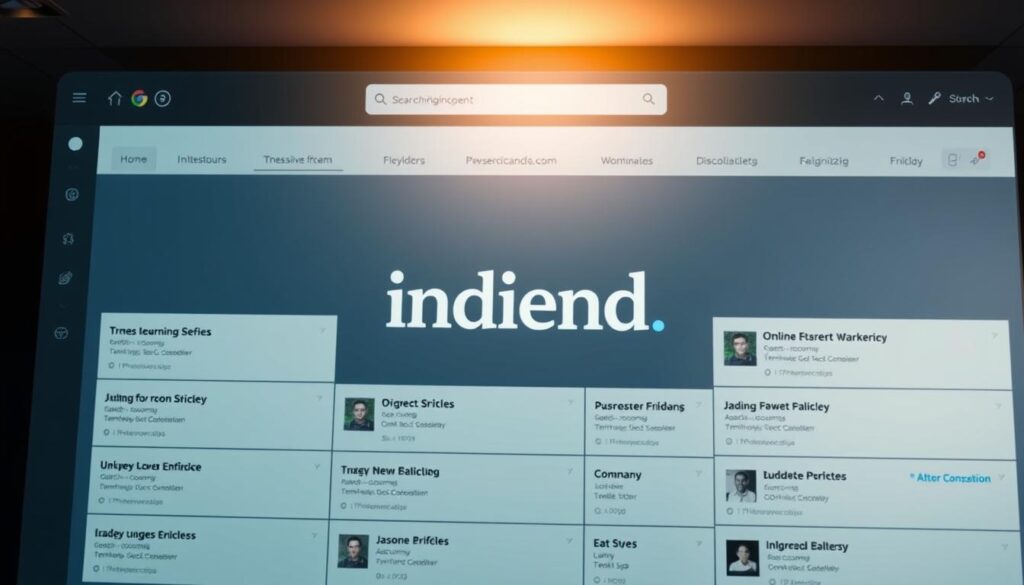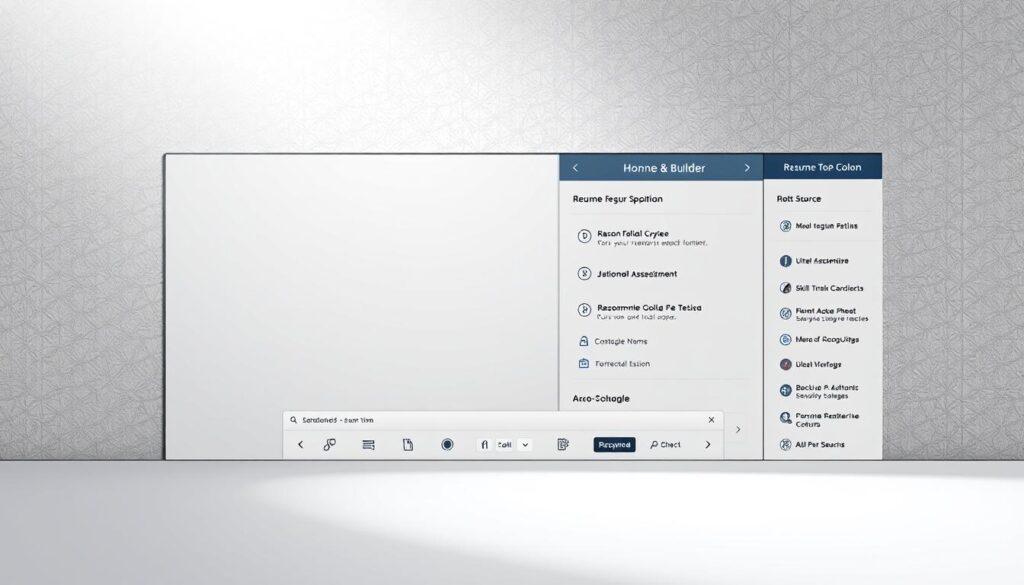Finding the right opportunity in today’s workforce can feel overwhelming. But with digital tools reshaping how employers connect with talent, your next role might be closer than you think. Did you know over 1 billion professionals use LinkedIn to showcase their skills? That’s just one example of how modern platforms are changing the game.
Gone are the days of flipping through newspaper ads. Today’s job seekers have instant access to millions of listings across specialized platforms. These resources let you apply with a click, connect directly with hiring teams, and even get alerts for roles matching your experience.
Why does this matter? The Society for Human Resources Management reports that 84% of companies now use online platforms for recruitment. Whether you’re updating your resume or building a standout profile, these tools help you stand out in a crowded market. Plus, features like AI-driven matches save hours of manual searching.
In this guide, we’ll explore platforms that simplify your hunt for the perfect fit. You’ll learn how to leverage networking features, filter opportunities by company culture, and present your skills effectively. Let’s dive into the resources that put your goals within reach.
Key Takeaways
- Digital platforms streamline applications and employer connections
- LinkedIn’s massive user base offers unmatched networking potential
- 84% of employers rely on online tools for hiring (SHRM data)
- AI matching reduces time spent searching for relevant roles
- Profile-building features help showcase skills to recruiters
Understanding the Modern Digital Job Market
Imagine landing your next role without leaving your living room. That’s the reality of today’s digital job market, where 76% of applicants use online platforms as their primary tool. The shift from newspaper classifieds to instant job boards has redefined how we explore careers.
Specialized websites now let you filter openings by industry, experience level, or even preferred work styles. A marketing professional in Chicago can find hybrid roles faster than brewing morning coffee. Employers benefit too – 63% report higher-quality candidates through digital channels compared to traditional methods.
| Method | Time to Apply | Average Reach |
|---|---|---|
| Newspaper Ads | 3-5 days | Local |
| Networking Events | 1 week | Industry-specific |
| Online Platforms | 15 minutes | Global |
Location features help narrow options without sacrificing opportunities. A nurse in Dallas sees nearby hospital openings first but can easily expand to statewide positions. Companies like IBM and Target now fill 40% of roles through their career portals, often before listings hit general boards.
For those seeking work, real-time alerts mean being first in line for dream positions. Employers gain access to verified skills and work histories, reducing hiring risks. This two-way efficiency explains why 89% of recent hires started their journey on job websites.
Features of the Best Career Search Engine
Modern platforms transform how candidates connect with opportunities. Key features like customizable filters let you sort roles by salary range, experience level, or company size. This precision helps avoid sifting through irrelevant listings.

Built-in tools simplify every step. Resume builders analyze your skills and suggest improvements, while application trackers notify you when employers view your profile. Some sites even offer interview prep resources through video tutorials or mock sessions.
| Feature | Benefit | Example |
|---|---|---|
| Advanced Filters | Pinpoint exact job requirements | Remote-only roles |
| Profile Storage | Apply with one click | Saved work history |
| Salary Insights | Compare offers fairly | Industry averages |
Many platforms now include instant apply options. Upload your resume once, and the site auto-fills future applications. This cuts submission time from 15 minutes to 30 seconds per position.
Unique functionalities set leading platforms apart. Some provide company culture quizzes to match your values with employers. Others use AI to alert you about job listings before they go public. These tools turn tedious searches into targeted missions.
LinkedIn: The Ultimate Networking Job Board
Your next career move might start with a single connection request. LinkedIn’s 1 billion users have transformed it into a hybrid platform where coffee chats meet job offers. Nearly 75% of hires happen through passive outreach, proving that networking isn’t just for conferences anymore.
Building a Professional Profile
Think of your LinkedIn profile as a living resume. Recruiters spend 6 seconds scanning it – so lead with achievements, not duties. A graphic designer might showcase portfolio pieces directly in their summary. A project manager could highlight certifications with clickable badges.
Endorsements and recommendations add credibility. One user landed a senior analyst role after a former colleague praised their data visualization skills publicly. Keep details updated – 87% of hiring managers verify profiles before interviews.
Leveraging Networking Features
LinkedIn’s algorithm favors active users. Commenting on industry posts increases visibility by 50%. Join groups related to your field – a teacher found her current role through a local education network’s job thread.
Use the Open to Work badge discreetly. It signals availability without alerting current employers. When reaching out, personalize messages. “Loved your article on UX trends” works better than generic requests.
Three people get hired every minute through LinkedIn. Whether you’re exploring roles or building connections, your next opportunity could be one click away.
Indeed: A Leader in Job Diversity
Clicking “apply” shouldn’t feel like running a marathon. With over 350 million monthly users, Indeed simplifies connecting talent with companies through its straightforward design. Whether you’re hunting for entry-level roles or executive positions, the platform’s diverse listings cater to every professional stage.

One-Click Applications Made Easy
Indeed’s Easy Apply feature lets you submit materials in seconds. No lengthy forms – just upload your resume once and reuse it across jobs. This option powers 30% of all applications on the platform, saving candidates hours weekly.
Recent graduates appreciate preset filters for “entry-level” roles, while seasoned professionals use salary comparison tools to negotiate better offers. Employers benefit too – 78% report faster hiring cycles through streamlined submissions.
- 250+ million resumes stored for quick access
- 10 new jobs posted every second globally
- Industry-specific filters narrow options instantly
Location-based searches adapt to your preferences. A barista in Miami sees nearby café openings first but can toggle to nationwide chains. Real-time alerts notify you when preferred employers post matching roles.
With tools like resume builders and company reviews, Indeed turns chaotic searches into organized missions. Next time you’re scrolling listings, remember – your ideal role might be one click away.
Glassdoor: Insights on Salaries and Company Culture
Knowing what to expect before accepting an offer can make all the difference. Glassdoor arms job seekers with real employee perspectives and verified salary data, turning guesswork into strategy. Over 70 million reviews and salary entries help users evaluate workplaces as thoroughly as employers assess candidates.
Exploring Company Reviews
Authentic employee feedback reveals what company websites won’t show. One software engineer discovered a team’s overtime expectations through reviews, avoiding burnout risks. Glassdoor’s anonymous structure encourages honest insights about management styles, growth opportunities, and work-life balance.
Using Salary Comparison Tools
Glassdoor’s salary calculator lets you filter pay ranges by location, experience, and job title. A marketing manager in Austin might learn they earn 12% below local averages – crucial information for negotiations. The platform also shows bonus structures and benefits trends across industries.
Combining job search efforts with cultural research saves time. Users avoid applying to roles that clash with their values. Over 55% of candidates say Glassdoor reviews influenced their application decisions. With tools to bookmark listings and set alerts, aligning opportunities with priorities becomes effortless.
Monster: Veteran Tools for Job Seekers
Polishing your resume shouldn’t require a magic touch. Monster’s 25+ years of experience helps job seekers present their skills with confidence. The platform combines time-tested methods with modern features, offering everything from application trackers to personalized career advice.

Resume Building and Application Tips
Monster’s resume builder analyzes your work history and suggests impactful phrasing. One user landed interviews at 3 Fortune 500 companies after restructuring their retail management experience using these tools. The system highlights overused words and recommends action verbs that catch hiring managers’ eyes.
Application strategies focus on efficiency. The platform teaches how to:
- Tailor resumes for specific roles in under 10 minutes
- Identify keywords from job descriptions
- Format documents to pass automated screening systems
Real-time tracking lets candidates monitor where their applications stand. A recent graduate shared how this feature helped them follow up strategically, leading to 42% more interview responses. Monster’s dashboard color-codes opportunities by response status – no more guessing games.
Weekly articles deliver practical job search tactics. From salary negotiation scripts to industry trend reports, the website turns overwhelming processes into manageable steps. As one marketing director put it: “Their checklist for virtual interviews transformed my preparation routine.”
Dice®: The Tech Sector’s Go-To Job Search Engine
Coding skills deserve a platform that speaks your language. Dice® focuses exclusively on tech roles, serving over 8 million professionals in fields like cybersecurity, AI development, and cloud engineering. Their tools understand niche requirements – think Kubernetes certifications or Python frameworks – that generic platforms often miss.

Tech Job Search Strategies
Success here starts with precision. Use Dice®’s industry-specific filters to target roles requiring exact programming languages or security clearances. One DevOps engineer found her current position by setting alerts for “Terraform” and “AWS Lambda” expertise. The platform’s AI analyzes your profile to suggest matches, cutting search time by 40% compared to broader sites.
Technical resumes need to pass both human and automated screens. Dice®’s builder emphasizes:
- Project portfolios with live demos
- Certification badges visible at first glance
- Open-source contributions as experience proof points
| Traditional Search | Dice® Approach |
|---|---|
| Generic “software engineer” listings | Roles requiring GraphQL or IoT skills |
| Manual salary research | Real-time pay data for blockchain developers |
| Broad company searches | Startups vs FAANG culture filters |
With 15,000 new tech jobs added weekly, the platform helps candidates stay ahead of hiring waves. 83% of users land interviews within 30 days when using personalized recommendation tools. Keep your profile updated – recruiters actively search for candidates with trending skills like quantum computing frameworks.
Pro tip: Engage with Dice®’s community forums. A data scientist recently discovered unlisted roles through peer discussions about emerging machine learning industry needs.
FlexJobs: Discovering Remote and Flexible Work
Working in pajamas isn’t just a weekend perk anymore. FlexJobs specializes in connecting professionals with verified remote work and hybrid roles across 50+ industries. Unlike general platforms, every listing undergoes human review to weed out scams – a game-changer for job seekers tired of sorting through sketchy postings.
The platform’s curated approach saves hours of searching. Filters let you specify preferences like “no phone work” or “4-day weeks.” A graphic designer might find freelance gigs with art studios, while project managers discover full-time roles offering location flexibility. Over 30,000 companies – from startups to Fortune 500s – post openings here.
While FlexJobs charges a subscription fee ($6.95-$15.95/month), users report higher-quality matches. One teacher transitioned to curriculum design work after finding 12 verified education sector listings in her state. The cost often pays for itself – members save $300+ monthly on average by avoiding commute expenses.
Key tools include:
- Skills tests to highlight in-demand abilities
- Salary comparison charts for remote roles
- Company research hubs with flexibility ratings
Whether you’re seeking part-time jobs or international contracts, this platform turns the chaos of online searches into targeted opportunities. As remote work becomes standard, having a vetted resource makes navigating the shift smoother – and maybe lets you keep those comfy pants a bit longer.
CareerBuilder®: A Time-Tested Job Search Platform
Your resume deserves a fighting chance in today’s competitive market. CareerBuilder® has connected professionals with employers for over 25 years, evolving alongside hiring technologies. Their platform combines decades of expertise with modern tools designed to navigate automated screening systems.
Mastering ATS Compatibility
Applicant Tracking Systems (ATS) scan 75% of resumes before human eyes see them. CareerBuilder®’s profile builder guides you through keyword placement and formatting that these systems favor. One user increased interview calls by 60% after restructuring their resume using these tools.
The platform’s smart analyzer checks for:
- Relevant industry terminology
- Proper header structures
- Skills matching job descriptions
| Traditional Resume | CareerBuilder® Optimized |
|---|---|
| “Managed team projects” | “Led 12 cross-departmental initiatives” |
| Basic skill listings | Certifications highlighted with dates |
| Generic objective statements | Role-specific summary paragraphs |
Mobile users benefit from real-time job alerts and profile editing features. The app’s “Quick Apply” function lets you submit materials during your commute. Recent updates include salary range displays for listed positions and company culture snapshots.
Keep your profile active – 43% of recruiters search CareerBuilder® daily for passive candidates. With resources like resume webinars and industry trend reports, staying ahead becomes part of your routine rather than a chore.
USAJOBS: Navigating Federal Job Opportunities
Securing a federal position requires navigating a unique hiring landscape. USAJOBS.gov serves as the official hub for government jobs, hosting over 30,000 active listings across 400+ agencies. Unlike private-sector platforms, every application here follows strict security protocols to protect sensitive candidate information.
Understanding the Federal Application Process
Federal roles demand meticulous attention to detail. The process typically involves:
- Creating a USAJOBS account with two-factor authentication
- Uploading resume documents meeting specific formatting rules
- Completing agency-specific questionnaires
Applications often require supporting documents like transcripts or veteran preference proofs. Missing one item can disqualify candidates – 68% of first-time applicants make preventable errors according to OPM data.
Setting Up Secure Profiles
Your USAJOBS profile acts as a master application. Key tips:
- Use official job titles from government classification standards
- Include exact dates for previous roles (month/year format)
- Enable email alerts for target series codes like GS-2210 for IT specialists
| Private Sector Profile | Federal Profile |
|---|---|
| Creative job titles | Standardized position names |
| Brief accomplishment summaries | Detailed duty descriptions |
| Flexible work dates | Exact employment timelines |
The platform’s resume builder tools help avoid common mistakes. Save multiple profile versions for different job categories – a cybersecurity expert might maintain separate profiles for analyst and engineer roles.
Google Jobs and Aggregators: Expanding Your Search Horizons
What if your next job found you instead of the other way around? Google Jobs scours thousands of websites – from corporate boards to niche platforms – to surface opportunities you might otherwise miss. This aggregator approach triples the average candidate’s visible listings, turning fragmented searches into centralized results.
Advanced Search Filters
Precision matters when sorting through millions of roles. Google’s filters let you specify:
- Commute times (with live traffic adjustments)
- Exact phrases like “Python developer” or “hybrid schedule”
- Posting dates to prioritize fresh listings
A teacher in Denver used the “education nonprofit” filter to discover 23 unadvertised roles. The platform even suggests related terms – searching for “content writer” might surface “copywriter” positions with higher pay ranges.
Custom alerts deliver matches straight to your inbox. Set preferences once, and get updates for roles meeting your salary needs or preferred employers. One user landed a project management role after an alert flagged a matching position 12 minutes post-listing.
Integration with Google’s core tools adds unique advantages. Voice search lets you ask, “Show me entry-level accounting jobs near Phoenix,” while map overlays display commute-friendly options. By pulling information from multiple sources, this approach turns overwhelming data into actionable steps.
Additional Job Boards and Niche Platforms to Consider
Your ideal role might be hiding in plain sight on niche platforms. While major sites dominate the market, specialized job boards often reveal opportunities tailored to unique skills or industries. These resources help you stand out in crowded fields while connecting with employers seeking specific expertise.
SimplyHired and ZipRecruiter’s Mobile Edge
SimplyHired simplifies comparing salaries across roles, showing what others in your industry earn. Its map view displays openings near favorite coffee shops or transit routes. ZipRecruiter’s AI matches candidates with roles 30% faster than manual searches, sending alerts when employers view your profile.
Both platforms excel in mobile design. Apply during your commute with one-tap submissions. ZipRecruiter’s instant chat feature lets you discuss details with hiring managers before formal interviews.
SkillUp’s Career Growth Toolkit
SkillUp targets professionals seeking advancement through free tools like resume analyzers and course libraries. A graphic designer doubled interview calls after using their template to highlight Adobe Suite certifications. The platform also partners with local organizations to offer training grants in high-demand fields like healthcare IT.
Examples of niche opportunities:
- Climate tech roles on GreenJobs
- Bilingual customer service positions on BilingualHire
- Nonprofit board seats on Idealist
Combining 2-3 sites creates a safety net for your job search. Track applications through centralized dashboards and compare employer responses. With tailored resources at your fingertips, uncovering the right fit becomes a strategic mission rather than a guessing game.
Conclusion
Your journey to the perfect role begins with the right tools. From LinkedIn’s networking power to Glassdoor’s salary insights, each platform offers unique advantages. Combining these resources creates a safety net in today’s fast-paced market.
Smart job seekers use filters to target roles matching their skills and values. Resume builders and interview prep tools turn anxiety into confidence. Remember: 84% of employers now prioritize online profiles when hiring.
Stay proactive with alerts for new jobs and updates from favorite companies. Optimize your profiles monthly – small tweaks can boost visibility by 30%. Whether exploring remote work or federal roles, these platforms put control back in your hands.
Ready to act? Revisit the sites that align with your goals. Update one profile today, set a search alert, or explore a niche board. Your next opportunity isn’t just out there – it’s waiting for you to hit “apply.”
